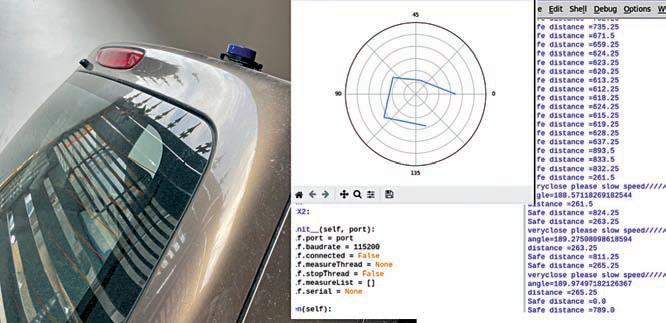
These use proximity sensors, cameras, and/or a lidar system. This project proposes to build a simple anti-collision system with a lidar.
Fig. 1 shows the lidar mounted on a car, along with the data generated by it for giving an alert. The components required to build the project are mentioned under Table 1.
You can use any lidar that is compatible with Python and has a Python SDK module for development, such as RPi lidar, YDLIDAR, Intel Real Sense lidar, and Velodyne lidar. The price of lidars available in the market varies considerably and so does their detection range. Most of them use USB serial communication.
In our design, we used YDLIDAR X2, but you can use any of the above-mentioned lidars. However, it is important to go through the datasheet (can search on Google) of the lidar and the Python module you are using to create the code around them.
In the datasheet, we can see the table that tells us that the field of view of this lidar is 360 degrees. So, this lidar can sense in any direction as it uses a motor to rotate. Some lidars provide 250- or 180-degree coverage only, so you need to choose the lidar as per your need.
The second important aspect of a lidar is its range and the conditions under which it can work. Some lidars use IR laser or red laser to work, some use doppler waves, and some others may be using yet another technology. So, to design a solution that works even in a foggy or rainy environment, we need to select the lidar accordingly.
In our design we have used laser-based YDLIDAR X2, whose parameters are given in Table 2 and whose image is shown in Fig. 2.
This story is from the June 2023 edition of Electronics For You.
Start your 7-day Magzter GOLD free trial to access thousands of curated premium stories, and 9,000+ magazines and newspapers.
Already a subscriber ? Sign In
This story is from the June 2023 edition of Electronics For You.
Start your 7-day Magzter GOLD free trial to access thousands of curated premium stories, and 9,000+ magazines and newspapers.
Already a subscriber? Sign In

ESP32-Powered AUDIO-VISUAL SIREN
This sound alternator is designed to simulate the effects of a police siren, combining sound and light to create a dynamic audio-visual experience.

BLDC MOTOR With Web-Based Speed Control Using ESP32
Integrating wireless control into brushless direct current (BLDC) motor systems opens up exciting possibilities for applications such as remote-controlled cars, robots, and other innovative systems.

Pi Zero Portable BILINGUAL TRANSLATOR
This system is designed as a bilingual translator, leveraging the gTTS library to support multiple Indian languages, including English (en), Bengali (bn), Gujarati (gu), Hindi (hi), Kannada (kn), Malayalam (ml), Marathi (mr), Tamil (ta), Telugu (te), and Urdu (ur).

Op-Amp-Based VEHICLE THEFT DETECTOR
A simple, low-cost device can effectively alert homeowners or occupants if a parked vehicle is moved or tampered with.

loT SMART METER With Dashboard
Energy meters in homes track electricity usage, enabling accurate billing by governments and providers.

Choose The Right Cloud Platform For Implementing loT PROTOCOLS
Working with loT protocols like MQTT, AMQP, and CoAP on cloud platforms is essential for developing scalable and efficient lol applications. The choice of the programming platform will depend on factors like project requirements, existing skills, and target devices. Leveraging the appropriate libraries and cloud services can enable seamless integration of lol devices with cloud-based applications.

Why TMR SENSORS Lead Next-Generation Design
TMR sensors are gaining traction in industries needing precision and power efficiency. What makes them the go-to choice for modern designs?

DESIGNING PCBs For EMI Management
Electromagnetic interference can derail your PCB’s performance. EMI management is not just a technical necessity but a hallmark of exceptional PCB design.

CUTTING COSTS, NOT CORNERS: Building Large Scale Applications With Open Source Software
Here are some strategies and best practices for leveraging open source to create enterprise-grade web and mobile applications without sacrificing quality or functionality.

"We Are One Of India's Very Few State Bodies To Manage The Entire Lifecycle Of The Electronics EcosystemFrom Approvals To Subsidies."
What is Gujarat State Electronics Mission GSEM), and how is it attracting major investments in electronics manufacturing, particularly semiconductor manufacturing, to Gujarat? To delve deeper, Electronics For You’s Nijhum Rudra spoke with Manish Gurwani, the head of GSEM. Here is what he revealed...